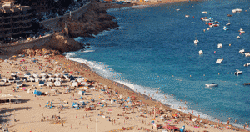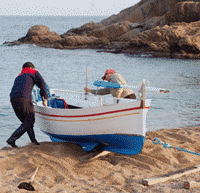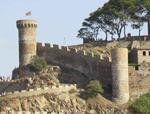The beach Platja Gran or Playa Grande in Tossa de Mar
From 19 beaches which are located in the area of Tossa only four are accessible from the town without taking a car. The biggest one of these beaches is the Platja Gran or, in Castilian, the Playa Grande. With its length of 430 metres and a width of maximum 60 metres it attracts each summer the majority of the tourists of this coastal place.
 Unfortunately Tossa de Mar allows at the predominantly sandy Playa Grande excursion boats in the summer, makes a part of the beach only available to the private boat owners and occupies a substantial part of the sand in the main vacation time by rented deck chairs, it remains only the half of the sand and the water for the "classical" bath vacation. Therefore, the Platja Gran is mostly overcrowded with people in July and August.
Unfortunately Tossa de Mar allows at the predominantly sandy Playa Grande excursion boats in the summer, makes a part of the beach only available to the private boat owners and occupies a substantial part of the sand in the main vacation time by rented deck chairs, it remains only the half of the sand and the water for the "classical" bath vacation. Therefore, the Platja Gran is mostly overcrowded with people in July and August.
Mostly only low waves reach the coast which permits that also children can play at the sandy beach and near the water of Platja Gran. Nevertheless, the water depth at the beach with the Blue Flag doesn't allow that children who can't swim enter the water without a strict surveillance by their parents.
By stormy weather high waves can transform the whole Tossa beach to a deathly trap. Some waves reach even the sea promenade and every carelessness can become deadly just like everywhere at the Mediterranean Sea.
Jellyfishes appear only very seldom near the Playa Grande of Tossa de Mar. Tourists are warned by suitable flags and loudspeaker announcements in good time. The water quality is generally good, nevertheless, by the rising amount of motorboats before the coast the quality is decreasing. By strong sea wind it sometimes happens that an aggregation of algae appears near the beach.
 A particular event at the Platja Gran is the moment when fishermen on their rowing boats head out to sea and their lights radiate over the Mediterranean Sea. Nevertheless, in Tossa itself no fish market takes place, the catch of the fishermen is for sale in Blanes.
A particular event at the Platja Gran is the moment when fishermen on their rowing boats head out to sea and their lights radiate over the Mediterranean Sea. Nevertheless, in Tossa itself no fish market takes place, the catch of the fishermen is for sale in Blanes.
The most significant beach of Tossa, the Platja Gran, offers a vew to the Old Town (Vila Vella ) with its medieval city wall and its seven to a great extent still to preserved watch-towers. Several significant pieces of art line the sea promenade. The most important works are the statue Minerva by F. Marés, the sculpture Testimoni by Bonavenura Ansón or a memorial stone to the Catalan author Jacint Verdaguer and his poem Canigó. Except of the Platja Gran only the beach Mar Menuda![]()
![]() which is close to the first one, got for many years now the Blue Flag.
which is close to the first one, got for many years now the Blue Flag.




